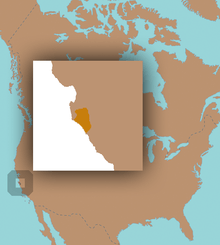Esselen language
Esselen was the language of the Esselen (or self-designated Huelel) Nation, which aboriginally occupied the mountainous Central Coast of California, immediately south of Monterey (Shaul 1995). It was probably a language isolate, though has been included as a part of the hypothetical Hokan proposal.
| Esselen | |
|---|---|
| Huelel | |
| Native to | United States |
| Region | Big Sur (California) |
| Ethnicity | Esselen |
| Extinct | 19th century |
Hokan ?
| |
| Language codes | |
| ISO 639-3 | esq |
| Glottolog | esse1238[1] |
 | |
Names
The name Esselen was derived from a village name. The Esselen people referred to their own language as Huelel. The name was recorded by Felipe Arroyo de la Cuesta on May 18, 1832 at Soledad Mission from his informant Eusebio (native name Sutasis) (cf. villel 'tongue' as recorded by Dionisio Alcalá Galiano) (Shaul 1995).
Historical background
French explorer Jean La Perouse, who visited Monterey in 1786, reported:[2]
The country of the Ecclemachs [Esselen] extends above 20 leagues to the [south]eastward of Monterey. Their language is totally different from all those of their neighbors, and has even more resemblance to the languages of Europe than to those of the Americas. This grammatical phenomenon, the most curious in this respect ever observed on the continent, will, perhaps, be interesting to those of the learned, who seek, in the analogy of languages, the history and genealogy of transplanted nations.
Esselen may have been the first Californian language to become extinct. Although it was spoken by many of the early converts at Mission Carmel, its use rapidly declined during the Hispanic period. Very little information on the vocabulary and grammar of Esselen was preserved. About 350 words and phrases and a few complete sentences have been preserved in literature, [2] including a short bilingual catechism (for a summary see Mithun 1999:411–413 and Golla 2011:114). By the beginning of the 20th century the only data on Esselen that investigators such as Kroeber and Harrington could collect were a few words remembered by speakers of other Indian languages in the area.
Classification
H. W. Henshaw thought that Esselen represented a monotypic linguistic family. Others have assigned the language to the Hokan family. While it is likely that much of Dixon & Kroeber's Hokan-Penutian model will stand the test of time, the subject matter is both complex and poorly understood, and is thus subject to revision.
Phonology
| Labial | Dental/ alveolar |
Retroflex | Palatal | Velar | Glottal | |||
|---|---|---|---|---|---|---|---|---|
| hard | soft | |||||||
| Nasal | m m | n n | ||||||
| Plosive | p p | t t | ʈ ṭ | k k | ʔ ' | |||
| Affricate | ts ts | tʃ č | ||||||
| Fricative | f f | s s | ʃ š | x x | h h | |||
| Approximant | w w | l l | j y | |||||
| Flap | ɾ r | |||||||
| Front | Back | |
|---|---|---|
| Close | i | u |
| Close-mid | e | o |
| Open-mid | ||
| Open | a |
Pronouns
Subject pronouns in Esselen (Shaul 1995):
sg pl 1 eni leṭ 2 neme nomeṭ 3 laṭ, lawis
Lexicon
Shaul (1995) reconstitutes Esselen vocabulary, synthesized from various historical sources, as follows.[3] Forms from Alfred L. Kroeber are marked by (Kr).
gloss Esselen adult -nVč all komVnam arrow lóto-s bear koltála bow paxu-nax child/son pana cry siawa dance mepV, mef- dark tumas (Kr) day asátsa die moho dog šošo drink etse, eše ear tus-usp (Kr) earth maṭa, matsa eight kxulef-walanai eyes -ikxpa father haya female ta- five pemakxa-la foot kxéle four kxamakxu-s friend -efe girl soléta give toxésa good/well sale- grandfather meči ground squirrel mexe hair haka head kxáta-sVx large putú-ki; yakí-s-ki man exe- mother atsia mountain polomo mountain lion xeke-s mouth iši nails uluxV night tomani-s nose xoši one pek person efexe pinole amúxe plain yala-x quail kumul (Kr) rabbit (cottontail) čiši, čis- salmon kilí- seal opopa-pas seven kxula-walanai six pek-walanai sky imi- small ukxu-s-ki speak al-pa sun aši teeth awur ten tomóila three kxulep two kxulax water asa-nax where kéya- who kíni wildcat toloma wood i'i yes íke
References
- Hammarström, Harald; Forkel, Robert; Haspelmath, Martin, eds. (2017). "Esselen". Glottolog 3.0. Jena, Germany: Max Planck Institute for the Science of Human History.
- "DCQ Fall Equinox 1999 -- The Caves Ranch". www.ventanawild.org. Retrieved 23 April 2020.
- Shaul, David L. 1995. "The Huelel (Esselen) Language." International Journal of American Linguistics 61:191-239.
Bibliography
- Golla, Victor. 2011. California Indian Languages. University of California Press.
- Mithun, Marianne. 1999. The Languages of Native North America. Cambridge University Press.
- Shaul, David L. 1995. "The Huelel (Esselen) Language." International Journal of American Linguistics 61:191-239.
External links
| Wiktionary has a word list at Appendix:Esselen word list |